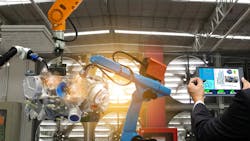In the digital age, smart manufacturers understand the pivotal role technology can play. This is true whether it’s embracing robotics, 3D printing, 5G or IoT. After all, the ability to strategically leverage technology often surfaces as the crucial turning point for manufacturers working to establish a competitive advantage. However, regardless of what technology a manufacturer deploys, maximizing the investment can be a challenge.
The key to maximizing tech integrations, according to Ed Macosky, senior vice president, product, UX and solutions at Boomi, rests with the manufacturer’s ability to effectively glean intelligence from the investment. “There is significant power in data,” he says. “It’s great to have a successful tech integration running and saving money. However, being able to glean intelligence from the movement of data takes the investment to the next level.”
Macosky tells IndustryWeek there are a few aspects that help manufacturers keep data in perspective:
Empower development strategically.
Being able to find ways to capture and utilize data to drive new efficiencies has fueled a movement towards easy to use, low code development. And for good reason – simple development empowers an array of personas to implement integrations very quickly. The benefit? Manufacturers have the unique ability to leverage skill sets from diverse team members. The drawback? Without proper planning focused on the right types of integrations, businesses can quickly create a sprawl. “You want to focus on the value to the end customer as well as the value to the business through maximized ROI,” Macosky says. “A solid strategy also helps avoid situations where production teams are building a bunch of stuff that has little value to the business, while creating a maintenance headache.”
Critique cloud versus on-prem.
While many of today’s connected environments put significant focus on cloud-based integrations, the ideal set-up is usually more of a hybrid environment. It is often better to look at it as a cloud-first approach questioning if it makes sense to move a certain component into the cloud. The reasoning for this approach is simple – manufacturers produce and utilize consistently large volumes of data. “Although it might be easier to go all in on the cloud, you need to find a healthy balance to avoid overpaying,” Macosky says. “It’s important to understand the economics of holding that all in the cloud. So, depending on the scenario may make sense. For instance, the cloud is great for applications that both run in the cloud and hold all of the data.”
Understand emerging technology’s role.
It is easy for the trendy technologies to become big – and costly – science projects when teams don't know what they're doing with it. Take blockchain as an example. Manufacturers could spin their wheels for a year devoting resources without any traction. However, paying attention to the use cases can help determine the right time to invest. “It is easy to go down the rabbit hole, focusing more on technology and buzzwords and less on the actual value to the business. And, what really matters with integration is providing value to the business,” Macosky says. “In manufacturing it is good to prototype some things but don't waste your time on the things that don't matter. You've got to find a healthy blend, and it's always a gamble but when is the right time to go in on new technology and find new ways to provide the business with an edge over competitors.”
About the Author
Peter Fretty
Managing Editor
As a highly experienced journalist, Peter Fretty regularly covers advances in manufacturing, information technology, and software. He has written thousands of feature articles, cover stories, and white papers for an assortment of trade journals, business publications, and consumer magazines.
